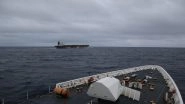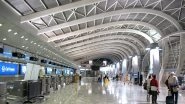Manila, Aug 18: A powerful earthquake struck a central Philippine region on Tuesday, trapping a family in a collapsed house, damaging other houses, low-slung buildings and a seaport and prompting people to dash outdoors for safety.
Roads and bridges were cracked in Cataingan, the coastal town nearest the epicenter, according to Rino Revalo, a Masbate provincial administrator, and initial images of the quake aftermath.
Also Read | US Heatwave: California Governor Gavin Newsom Signs Emergency Heatwave Proclamation.
A Cataingan resident, Isagani Libatan, said he was on his way to his aunt's house for breakfast when his motorcycle suddenly swayed from left to right as the ground heaved.
“I thought it was my tire but people suddenly streamed out in panic from swaying houses then we lost power,” Libatan told The Associated Press by telephone, pausing briefly as he felt another fairly strong aftershock.
Revalo told ABS-CBN network that a three-story house collapsed in Cataingan as the ground shook and trapped a retired police officer and his family. Rescuers scrambled to save them, he said.
“People should avoid returning immediately to damaged structures,” he said. The Philippine Institute of Volcanology and Seismology said the 6.6 magnitude quake hit about 5 kilometers (3 miles) from Cataingan at a depth of about 21 kilometers (13 miles).
Renato Solidum, who heads the government institute, said there was no threat of a tsunami from the earthquake, which was set off by movement in the Philippine Fault. The quake was felt in several provinces across the central Visayas region.
The Philippines lies in the Pacific “Ring of Fire,” an arc of faults around the Pacific Ocean where most of the world's earthquakes occur. It's also lashed by about 20 typhoons and storms each year, making it one of the world's most disaster-prone countries.
A magnitude 7.7 quake killed nearly 2,000 people in the northern Philippines in 1990.
(The above story is verified and authored by Press Trust of India (PTI) staff. PTI, India’s premier news agency, employs more than 400 journalists and 500 stringers to cover almost every district and small town in India.. The views appearing in the above post do not reflect the opinions of LatestLY)













 Quickly
Quickly


